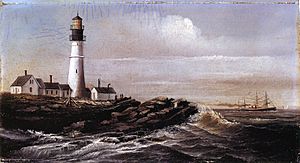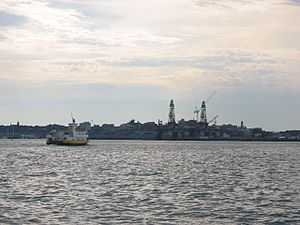Casco Bay facts for kids
Casco Bay is a beautiful inlet of the Gulf of Maine on the southern coast of Maine, New England, in the United States. It stretches from Cape Small in the east to Two Lights in Cape Elizabeth in the west. The city of Portland is located along its southern edge, and the busy Port of Portland is found within the bay.
Contents
What's in a Name?
There are two main ideas about how Casco Bay got its name.
An Ancient Name
One idea is that the name comes from the Abenaki people, who are Native Americans. They called the bay Aucocisco, which means "place of herons." Sometimes it's also translated as "muddy," referring to the bay's bottom.
A Spanish Explorer's Name
Another idea comes from a Portuguese explorer named Estêvão Gomes. In 1525, he mapped Maine's coast. He supposedly named the bay "Bahía de Cascos," which means "Bay of Helmets." This name might have come from the shape of the bay or perhaps the helmets worn by his crew.
Early Settlements and History
The first attempt by Europeans to settle in Casco Bay was by Captain Christopher Levett, an English explorer. He built a house on House Island in 1623–24, but this settlement didn't last.
The first lasting settlement on the bay was simply called Casco. Even though its name changed over time, this settlement grew into the largest city in the area, which we now know as Portland, Maine.
The "Calendar Islands"
In 1700, an English military engineer named Colonel Wolfgang William Römer said that the bay had "as many islands as there are days in the year." This led to the bay's islands being called the "Calendar Islands." However, this is a popular myth! The United States Coastal Pilot lists 136 islands, and a former Maine historian said there are "little more than two hundred islands." So, not quite 365!
Native American History
When Europeans first arrived in the 1500s, the area around Casco Bay was home to people who spoke an Eastern dialect of the Wabanaki language.
Treaties and Conflicts
Many important agreements, called treaties, were made between the British colonies and members of the Wabanaki Confederacy in Casco Bay. These included the Treaty of Casco (1678), the Treaty of Casco (1703), and the Treaty of Casco Bay (1727). These treaties aimed to keep the peace and set rules for how everyone would live together.
During King William's War in 1690, there was a major attack on the English settlement at Casco Bay. French and Native American forces attacked Fort Loyal. After four days of fighting, the settlers surrendered, expecting safe passage. Sadly, most of the men were killed, and the remaining settlers were taken captive.
Casco Bay in Wars
Casco Bay has played a role in several wars throughout history.
War of 1812
During the War of 1812, military forts were built around Casco Bay. Some of these old forts are still there today.
American Civil War
Fort Gorges, located on Hog Island Ledge in the middle of Portland Harbor, was built during the American Civil War.
World War II
In World War II, Casco Bay was a very important place for the US Navy. It was used as a safe place for ships to anchor, especially for those involved in sending supplies to Britain.
Famous Residents and Culture
Eagle Island is a State Historic Site. It was the summer home of Arctic explorer Robert Peary, who is famous for his expeditions to the North Pole.
Movies and Music
- The movie The Whales of August, starring Bette Davis, was filmed here in 1987.
- In 2008, two composers, Peter J. McLaughlin and Akiva G. Zamcheck, wrote music about a ship called the Don that sank near Ragged Island in 1941.
Marine Life and Economy
Casco Bay is a lively place for both marine animals and human activities.
Fishing and Lobstering
Portland has a large fleet of deep-sea fishing boats that bring their catch to the Portland Fish Exchange. Many towns and islands around the bay are home to lobster boats, which catch delicious lobsters. You can also charter boats for recreational fishing.
Marinas and Boat Services
There are many marinas and boat services around the bay where boats can dock and be repaired. Some of these include:
- Chebeague Island Boat Yard on Great Chebeague Island
- DiMillo's Old Port Marina in Portland
- Paul's Marina in Brunswick
- Peaks Island Marina on Peaks Island
- Yarmouth Boat Yard in Yarmouth Harbor
Ship Repair
From the 1980s to the 1990s, a company called Bath Iron Works used a special dry dock in Portland Harbor to repair U.S. Navy ships.
Animals of Casco Bay
Casco Bay is home to many different kinds of animals.
Fish and Shellfish
Common fish in the bay include mackerel, striped bass, and bluefish. You can also find shellfish like lobsters, crabs, mussels, clams, and snails.
Mammals and Birds
Harbor seals often gather on rocky ledges. Sometimes, whales swim into the bay, and even into Portland Harbor! The most common birds you'll see are seagulls, cormorants, and different types of ducks. More rarely, you might spot osprey, eagles, and herons. The muddy bottoms of the bay are important homes for many of these creatures.
Getting Around the Bay
The main islands in Casco Bay are connected by the Casco Bay Lines ferry service, which leaves from the Maine State Pier in Portland.
Ferry Services
- Peaks Island is served by a car ferry and has many trips each day during the summer.
- Other islands like Great and Little Diamond islands and Long Island are served by the Diamond Pass run, which is popular with tourists.
- Casco Bay Lines also offers a daily mailboat run, a cruise to Bailey Island, and a sunset trip.
Other Options
Water taxis are another popular way to get around the bay, especially for smaller groups.
Towns and Islands of Casco Bay
Many towns and islands are located along the beautiful shores of Casco Bay.
Notable Cities and Towns
Here are some of the towns you'll find around the bay, listed from south to north:
- Cape Elizabeth
- South Portland
- Portland
- Falmouth
- Cumberland
- Yarmouth
- Freeport
- Brunswick
- Harpswell
- West Bath
- Phippsburg
Major Islands
- Bailey Island
- Bustins Island
- Cliff Island
- Cousins Island
- Cushing Island
- Great Chebeague Island
- Great Diamond Island
- Long Island
- Mackworth Island
- Orr's Island
- Peaks Island
- Sebascodegan Island
Minor Islands
- Bangs Island
- Basket Island
- Barnes Island
- Bartol Island
- Basin Island
- Bates Island
- Bear Island
- Ben Island
- Big Hen Island
- Birch Island
- Bombazine Island
- Bowman Island
- Bragdon Island
- Burnt Coat Island
- Bush Island
- Center Island
- Clapboard Island
- College Island
- Coombs Islands
- Cow Island
- Crab Island
- Crow Island
- Dingley Island
- Eagle Island
- East Brown Cow Island
- Elm Islands
- French Island
- Frye Island
- George Island
- Gooseberry Island
- Goose Nest Island
- Great Mark Island
- Halfway Rock
- Harbor Island
- Haskell Island
- Hog Island
- Hope Island
- Horse Island
- Home Island
- House Island
- Inner Green Island
- Irony Island
- Jacquish Island
- Jenny Island
- Jewell Island
- Junk of Pork
- Lanes Island
- Little Bustins Island
- Little Chebeague Island
- Little Birch Island
- Little Diamond Island
- Little French Island
- Littlejohn Island
- Little Mark Island
- Little Moshier Island
- Little Snow Island
- Little Whaleboat Island
- Little Wood Island
- Lower Goose Island
- Malaga Island
- Mark Island
- Ministerial Island
- Moshier Island
- Mouse Island
- Outer Green Island
- Overset Island
- Pettingill Island
- Pinkham Island
- Pole Island
- Pound of Tea
- Pumpkin Nob
- Ragged Island
- Ram Island
- Raspberry Island
- Rogue Island
- Sand Island
- Scrag Island
- Sheep Island
- Shelter Island
- Snow Island
- Stave Island (home to Survivor: Gabon winner Bob Crowley)
- Stockman Island
- Sister Island
- Sow and Pigs
- Sturdivant Island
- Turnip Island
- Two Bush Island
- Upper Flag Island
- Upper Goose Island
- Upper Green Island
- The Brothers
- The Goslings
- The Nubbin
- Vail Island
- Whaleboat Island
- White Island
- White Bull Island
- Williams Island
- Wood Island
- Yarmouth Island
Lighthouses of Casco Bay
Casco Bay is home to 6 beautiful lighthouses that guide ships safely:
- Cape Elizabeth Lights
- Portland Head Light
- Ram Island Ledge Light
- Spring Point Ledge Light
- Portland Breakwater (Bug) Light
- Halfway Rock Light
Historic Forts
Several historic forts are located in Casco Bay:
| Fort | Built | Location |
|---|---|---|
| Fort Gorges | 1865 | Hog Island Ledge, Portland, ME |
| Fort Levett | 1898 | Cushing Island, Portland, ME |
| Fort Lyon | 1909 | Cow Island, Portland, ME |
| Fort McKinley | 1907 | Great Diamond Island, Portland, ME |
| Fort Preble | 1808 | Southern Maine Community College/Spring Point Ledge Light, South Portland, ME |
| Fort Scammel | 1808 | House Island, Portland, ME |
| Fort Williams | 1872 | Fort Williams Park, Cape Elizabeth, ME |
| Battery Steele | 1942 | Peaks Island, Portland, ME |
Local News
If you want to read about what's happening in Casco Bay, here are some newspapers:
- The main newspaper for Portland is the Portland Press Herald. On Sundays, it's called the Maine Sunday Telegram.
- The Working Waterfront is a free monthly newspaper that shares news about Maine's coast and islands.
- The Forecaster is published weekly and covers news, obituaries, and sports for Southern Maine.
- In the early 1900s, there was a newspaper called the Casco Bay Breeze that reported on island news from 1901 to 1917. You can find old copies of it online for free!



